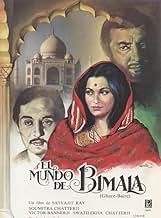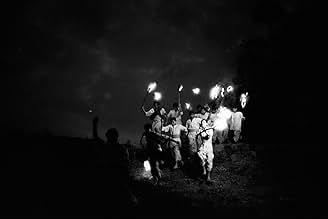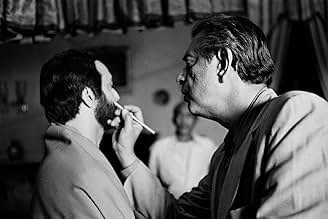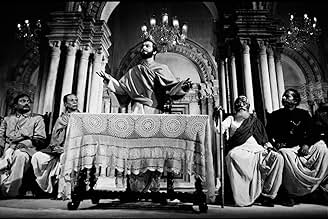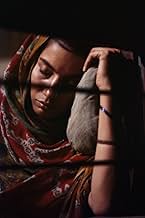AVALIAÇÃO DA IMDb
7,5/10
2 mil
SUA AVALIAÇÃO
Adicionar um enredo no seu idiomaA landowner's wife emerges from seclusion through education, defying social norms. Her newfound freedom leads to political awakening when her husband's old friend brings revolutionary ideas ... Ler tudoA landowner's wife emerges from seclusion through education, defying social norms. Her newfound freedom leads to political awakening when her husband's old friend brings revolutionary ideas to their door.A landowner's wife emerges from seclusion through education, defying social norms. Her newfound freedom leads to political awakening when her husband's old friend brings revolutionary ideas to their door.
- Direção
- Roteiristas
- Artistas
- Prêmios
- 3 vitórias e 2 indicações no total
Soumitra Chatterjee
- Sandip Mukherjee
- (as Soumitra Chattopadhyay)
Swatilekha Sengupta
- Bimala Choudhury
- (as Swatilekha Chattopadhyay)
Jennifer Kendal
- Miss Gilby
- (as Jennifer Kapoor)
Bimala Chatterjee
- Kulada
- (as Bimal Chattopadhyay)
- Direção
- Roteiristas
- Elenco e equipe completos
- Produção, bilheteria e muito mais no IMDbPro
Avaliações em destaque
The Home and The World is an excellent film by the great Bengali director Satyajit Ray. Based on a novel by Tagore, the drama focuses on the personal and political dilemmas faced by a wealthy Bengali woman in 1907 as her husband and his best friend vie for her affection and her political loyalties.
Very few films successfully focus on the ethical complexities of social movement organizing (The Official Story, Matewan, and Mapantsula are rare exceptions; The Way We Were has some brilliant flashes along these lines, but then veers away from these themes all too quickly). We, the viewers, are initially drawn to the viewpoint of the charismatic political organizer, just as the protagonist is drawn to him and out of the restraints of traditional purdah. Far from painting the husband as a vile monster to revolt against, however, the husband encourages the increasing independence of the protagonist, and becomes the loving conscience of the film, even as it exposes the limitations of his apparent passivity.
As the attraction between the protagonist and the organizer mounts, so does the tempo and the tension of the political struggles in the village. As the protagonist learns more and more about the world beyond the secluded part of her palatial home, we, the viewers, begin to understand more and more the complexity of the cross-cutting tensions between: England and India, modernism and tradition, Hindu and Muslim, rich and poor, men and women, leadership and rabble-rousing, means and ends, and love and infatuation.
All this could have been ponderous or didactic, but it's decidedly not, and one of the wonders of the film is that the political issues are woven so deftly into the story of a believable unfolding love triangle. Most movies have a difficult time portraying any motivation for two characters to `fall' in love - this movie manages to portray changes in the relationships between all three main characters with such precision and intensity that I fully believed, and cared deeply, about each one.
The acting is extraordinary, and the cinematography, as is usual in Ray's films, is breathtaking, subtly accentuating the movie's themes of liberation and loss, and the interplay between the two.
Ray said his goal as a director was the same as Renoir's, to show that everyone has their reasons. As perhaps the most warmly compassionate of directors in all of world cinema, he succeeds brilliantly with this film.
Very few films successfully focus on the ethical complexities of social movement organizing (The Official Story, Matewan, and Mapantsula are rare exceptions; The Way We Were has some brilliant flashes along these lines, but then veers away from these themes all too quickly). We, the viewers, are initially drawn to the viewpoint of the charismatic political organizer, just as the protagonist is drawn to him and out of the restraints of traditional purdah. Far from painting the husband as a vile monster to revolt against, however, the husband encourages the increasing independence of the protagonist, and becomes the loving conscience of the film, even as it exposes the limitations of his apparent passivity.
As the attraction between the protagonist and the organizer mounts, so does the tempo and the tension of the political struggles in the village. As the protagonist learns more and more about the world beyond the secluded part of her palatial home, we, the viewers, begin to understand more and more the complexity of the cross-cutting tensions between: England and India, modernism and tradition, Hindu and Muslim, rich and poor, men and women, leadership and rabble-rousing, means and ends, and love and infatuation.
All this could have been ponderous or didactic, but it's decidedly not, and one of the wonders of the film is that the political issues are woven so deftly into the story of a believable unfolding love triangle. Most movies have a difficult time portraying any motivation for two characters to `fall' in love - this movie manages to portray changes in the relationships between all three main characters with such precision and intensity that I fully believed, and cared deeply, about each one.
The acting is extraordinary, and the cinematography, as is usual in Ray's films, is breathtaking, subtly accentuating the movie's themes of liberation and loss, and the interplay between the two.
Ray said his goal as a director was the same as Renoir's, to show that everyone has their reasons. As perhaps the most warmly compassionate of directors in all of world cinema, he succeeds brilliantly with this film.
"Dear me, I had no conception that the lower classes had such white skins." - Lord Curzon
Set in the early 1900s, Satyajit Ray's "The Home and the World" features the recollections of Bimala Cloudhury (Swatilekha Chatterjee), the wife of Nikhilesh (Victor Banerjee), a wealthy Bengal merchant. As her spouse encourages her to adopt Western attitudes, Bimala begins to drift away from traditional social and religious values.
By "Home's" second act, it becomes clear that Nikhilesh idolises India's British rulers, who, under the leadership of Lord Curzon, have begun partitioning the Muslim and Hindu populations of Bengal. Ironically, Nikhilesh's desires for Bimala to be "reeducated" have the opposite effect; she's drawn toward a leader of the Swadeshi, a nationalist movement. Indeed, Bimala becomes the movement's first female member.
"Home" thus sketches an India in which forces have begun pulling in opposing directions. Throughout the film, traditional values vie with liberated modernism. This "modernism", ironically, is introduced via the "primitive" hand of British Imperialism, which is itself opposed by an Indian Nationalism whose progressivism not only masks reactionary elements, but points to the eventual disharmony between Hindus and Muslims.
Slow, subtle, and set almost entirely indoors, "The Home and the World" heavily resembles the works of Luchuno Visconti. Like Visconti at his best, Ray's film portrays a society on the cusp of transformation. Bimala's plight, torn between two men, itself echoes the upheaval's of her nation.
8/10 – See "North West Frontier".
Set in the early 1900s, Satyajit Ray's "The Home and the World" features the recollections of Bimala Cloudhury (Swatilekha Chatterjee), the wife of Nikhilesh (Victor Banerjee), a wealthy Bengal merchant. As her spouse encourages her to adopt Western attitudes, Bimala begins to drift away from traditional social and religious values.
By "Home's" second act, it becomes clear that Nikhilesh idolises India's British rulers, who, under the leadership of Lord Curzon, have begun partitioning the Muslim and Hindu populations of Bengal. Ironically, Nikhilesh's desires for Bimala to be "reeducated" have the opposite effect; she's drawn toward a leader of the Swadeshi, a nationalist movement. Indeed, Bimala becomes the movement's first female member.
"Home" thus sketches an India in which forces have begun pulling in opposing directions. Throughout the film, traditional values vie with liberated modernism. This "modernism", ironically, is introduced via the "primitive" hand of British Imperialism, which is itself opposed by an Indian Nationalism whose progressivism not only masks reactionary elements, but points to the eventual disharmony between Hindus and Muslims.
Slow, subtle, and set almost entirely indoors, "The Home and the World" heavily resembles the works of Luchuno Visconti. Like Visconti at his best, Ray's film portrays a society on the cusp of transformation. Bimala's plight, torn between two men, itself echoes the upheaval's of her nation.
8/10 – See "North West Frontier".
I have literally no words to describe this film! Throughout the film, I felt that I was transported back to the early 20th century and watching the events unfold in front of my eyes.
Bimala, the wife of a Bengali zamindar/gentry is the main protagonist of the film. Her conflicts, her transformations (no spoilers) are the main events occuring in the film. To enjoy the flavour of the film, I would suggest you to watch the film from the POV of her.
The film illustrates the two sides of the Swadeshi movement. One group felt that Swadeshi movement was unrealistic and the poor would be hard hit. Another group, the utopian one, felt that Swadeshi would bring freedom to India.
Bimala, the wife of a Bengali zamindar/gentry is the main protagonist of the film. Her conflicts, her transformations (no spoilers) are the main events occuring in the film. To enjoy the flavour of the film, I would suggest you to watch the film from the POV of her.
The film illustrates the two sides of the Swadeshi movement. One group felt that Swadeshi movement was unrealistic and the poor would be hard hit. Another group, the utopian one, felt that Swadeshi would bring freedom to India.
Here is one more film made our of the work of Tagore. The great Kishore Kumar gave his voice for a song in this film. The worst script adapted by Ray I think. It always bugged me how the entire story was converted to a play and the film was made plainly out of it. The story it interesting though - it shows how the 'boycott British product' movement in early 1900s impacted poor people in our country.
Read about the great Indian debate between Gandhi and Tagore before watching this movie.
You can see Gandhi in the character of Sandip and Tagore in the character of Nikhil.
Now watch this movie. An absolute masterpiece
Você sabia?
- CuriosidadesBased on the book "Ghare-Baire" by Rabindranath Tagore. Director Satyajit Ray had previously written a screenplay from this book, but had sold the rights to a group who never filmed the story. 30 years later, Ray rewrote the screenplay for this film.
- ConexõesReferenced in Z Channel: A Magnificent Obsession (2004)
Principais escolhas
Faça login para avaliar e ver a lista de recomendações personalizadas
- How long is The Home and the World?Fornecido pela Alexa
Detalhes
Bilheteria
- Faturamento bruto mundial
- US$ 6.951
- Tempo de duração
- 2 h 20 min(140 min)
- Mixagem de som
Contribua para esta página
Sugerir uma alteração ou adicionar conteúdo ausente

